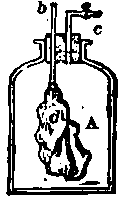Why The Lungs Remain Expanded
Description
This section is from the book "The Human Body: An Elementary Text-Book Of Anatomy, Physiology, And Hygiene", by H. Newell Martin. Also available from Amazon: The Human Body.
Why The Lungs Remain Expanded
We may best understand this by considering a thin india-rubber bag, such as a toy balloon. If the neck of the bag is open it collapses. Why ? Because the atmosphere, which pushes on all things near the earth's surface with a pressure of about 15 lbs. on each square inch (1033 grams on each square centimetre), presses equally on the outside and the inside of the bag. These pressures balance one another, and the bag collapses on account of its elastic contractility.
We can expand such a bag in two ways. We may blow air into it forcibly, and so make the pressure inside sufficiently greater than the opposing aerial pressure outside to overcome the elasticity of the bag. But we can also distend the bag, not by increasing the aerial pressure inside it, but by diminishing that outside it.
Suppose (Fig. 67) we tie our rubber bag (d) on the lower end of the tube b, which, like the tube c, passes air-tight through a cork, and then fit the cork tightly into the glass bottle a. The air will then press with its full weight on the inside of the bag through b and on the outside of it through c, and the bag will remain collapsed. If now we suck air out through c we diminish its pressure on the outside of the bag without altering the atmospheric pressure on its inside: d will therefore begin to expand, because the pressure inside it is no longer counterbalanced by the pressure outside. The more air we suck out of c (that is, the more we diminish the atmospheric pressure on the exterior of d) the more will the bag expand. Finally, if the rubber bag is distensible enough, when all the air in the bottle is sucked out d will be distended by the push of the air inside it until it completely fills the bottle, whose walls prevent it from going any farther. If now we open c and let in the outside air, the bag will again collapse to its original shrunken dimensions.

Fig. 67. Diagram illustrating the pressure relationships of the lungs in the thorax.
Why does a thin rubber bag collapse when its neck is open ?
How can we expand such an elastic bag? Describe a model illustrating the means by which the lungs are kept expanded in the chest-and explain its action?
Application To The Lungs
The above experiment illustrates very perfectly how the lungs are kept distended during life. The chest is an air-tight chamber containing, among other things, the elastic hollow lungs. On the interior of the lungs the weight of the atmosphere presses through the air-passages which lead to them, and answer to the tube b in Fig. 67. Outside the lungs in the thorax there is no air at all, and the uneounterpoised aerial pressure inside them overcomes their tendency to shrink, and expands them so as to completely fill all holes and corners of the thoracic chamber not occupied by other organs. If, however, we make a hole in the chest wall and let the air press on the outside of the lungs they collapse at once.
Continue to:
